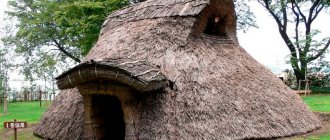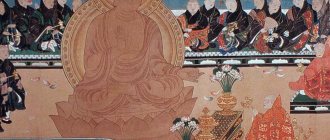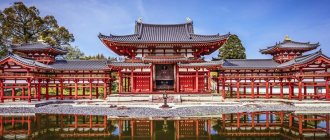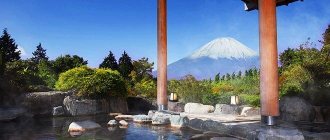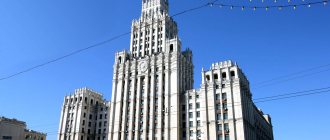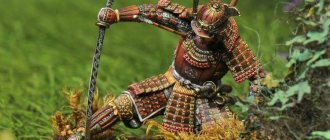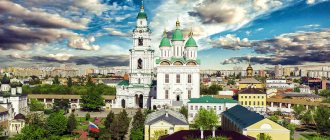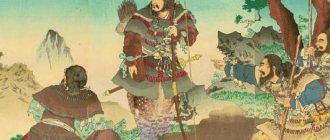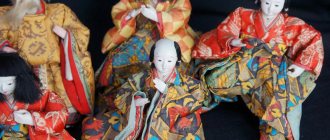Each branch of Japanese culture carries within itself the extraordinary features of the life and traditions of the Japanese inhabitants. Temples in Japan are no exception. They perform many primary functions, the main one of which is the preservation of religious traditions. Temples are representatives of sacred architecture, which the Japanese treat with special reverence. In addition, Japanese temples are considered cultural monuments with special parameters that set them apart from the sights of other countries. Japanese temples have characteristic details in a consistent classical style, complemented by eclectic elements.
Buddhist temples in Japan
Buddhism in Japan became not just a new ideology, which largely affected the way of life of society, but also laid the foundation for new architectural forms and additional techniques in the field of construction. A Buddhist temple in Japan, as a rule, has a massive roof, on which there is a long spire that reaches into the sky. The architecture of Buddhist temples in Japan is based on the presence of four basic elements - columns, sloped roofs, crossbars and intricate roofing.
Enryaku-ji Temple
This Buddhist temple is located on Mount Hiei, which is located near the city of Kyoto. The structure was built in the early 8th century by a Buddhist named Saicho. For quite a long time, right up to the present day, the activities of the Tendai school have been carried out on the territory of the temple. Also, Enryaku-ji contains the movement of such schools as Nichiren, the school of Pure Lands and Zen. Today, the temple can be considered one of the most popular Buddhist temples.
The activities of the monks on the territory of the monastery began in 807 under the leadership of the founder. He was supported by Emperor Kammu, who was in power at that moment. The training lasted twelve years. One hundred students took part in the learning process. The monks spent all the time allotted for acquiring skills in meditation, studying the basics of Buddhism. Strict discipline reigned in the monastery, which helped students reach certain heights. The best of the monks continued to serve in Enryaku-ji, others found themselves in government positions. Over time, the temple grew, at the very peak of its prosperity, it was a whole complex, which included 3,000 temples. The monastery had its own army, which often took part in bloody wars, defending the interests of the temple.
Today the temple complex contains three parts. In the eastern hall, which is called Todo, once upon a time there was the main figure of the monastery. The western hall of the temple is called Saito, it performs a similar function to the previous hall. The third part of the temple complex was named Yokawa.
Ryoan-ji Temple
The temple is located in Kyoto. Today it is somewhat different from its original state, since repeated fires contributed to the reconstruction of its walls. Ryoan-ji is of great importance to the Japanese people and is included in the UNESCO World Heritage List.
The main distinctive feature of the temple is the rock garden located on its territory. It is considered the main symbol of Kyoto. It is noteworthy that there is absolutely no vegetation in this garden. It appears to tourists exactly in the form in which it was originally created. The author of this cultural heritage is Soami, a master with an impressive reputation. The rock garden attracts even people who are far from Buddhism, because its contemplation makes you think about deep things and get to know yourself.
In addition to the rock garden, on the territory of the temple complex you can find a picturesque lake, through which small bridges pass. There is also a tea garden, which not everyone can get into. There is a walking path along the lake.
Todai-ji Temple
This representative of Buddhist temples is protected in a special way, since it is a UNESCO site. Todai-ji was located in Nara. It is called the largest temple, which is built of wood. The temple not only represents religiosity, but is also an extremely beautiful monument of Japanese culture. The territory of the complex is quite large; it is located in the very heart of the city. The hallmark of the building can be considered the southern gate, which reaches a height of 25 meters. Next to them you can see multiple wooden figures that attract attention with their masterful execution.
In addition to the southern gate, there are others, including the central one. In close proximity to them there is an incense burner. Passing by it, some tourists try to get into the clouds of smoke for a while. This tradition is typical for Buddhist temples. It is performed in order to cleanse your body and soul.
On the territory of Todai-ji there is a deer park where you can meet free-ranging deer. Another feature of the temple complex is the Buddha statue made of bronze. The floor of the hall where it is located is paved with stone slabs. Buddha is depicted on lotus leaves, which, like the main figure, are made of bronze. The Buddha image looks very realistic, as intended by the great masters
Kofuku-ji Temple
If we were to list the most popular temples of ancient Japan, then Kofuku-ji would undoubtedly take pride of place on this list. To see it, just visit the city of Nara.
Kofuku-ji was originally located in Kyoto and was later transferred to Nara. At the moment, it is classified as a UNESCO protected site and is considered one of the seven largest structures in the south of the country.
The founder of the temple was the Fujiwara clan. During its existence, the temple experienced both decline and prosperity. In the Middle Ages, Kofuku-ji was distinguished by the presence of a professional army. This was the reason for participation in a brutal war, which did not bring anything good to the temple. After its completion, Kofuku-ji experienced difficult times.
The temple stands out from similar structures with its pagoda, which is 50.8 meters in height and has five floors. Over time, it was reconstructed and changed. Another, no less beautiful pagoda, contains three floors. It is considered the oldest. In 1180 it survived a global fire, but was soon rebuilt.
Kotoku-in Temple
The temple stands out for its Buddha statue, which amazes tourists with its scale. It is not just a highlight and an obligatory attribute of the temple, but also a real landmark of the entire city of Kamakura, where the temple is located.
Minamoto no Yoritomo was the first to propose creating such a majestic Buddha statue on the temple grounds. However, he did not have time to carry out his idea, as he died suddenly. After his death, Inada began to implement the plan. The funds used to erect the statue were donations from people all over the area.
Kotoku-in suffered severe damage during a massive earthquake. After him, the statue was in a deplorable state for a long time. Later we managed to raise money for its reconstruction. However, the Buddha appears today not in the form in which he was originally. Previously, it was completely covered with gilding, but now it remains only on the ears of the statue.
Construction of the main temple complex
The statue began to be erected in 744 by order of the emperor. The costs of its construction were so great that they devastated the imperial treasury.
The Bishop appealed to the population to assist in the construction of the statue of Buddha Vairocana. Even if the donor could only give a little, it was accepted with joy.
The Big Buddha is a huge bronze statue just over 16 meters high. His statue is not valuable from an artistic point of view, but is famous for its size and the amount of material that went into its manufacture.
Up to the shoulders, it is assembled from forty parts. The head and neck are cast in one mold 4 meters high. The hairpiece on the head consists of 966 curls. Buddha sits on a throne of lotus petals.
To imagine the scale of the statue, it is interesting to know this fact. In one of the columns of the temple above the floor there is a hole made, corresponding in size to the Buddha's nostril. It is believed that if you climb through it, you will find good luck and enlightenment.
The statue was placed in the wooden Daibutsuden - the hall of the great Buddha, which was the main building of Todai-ji, Nara's most famous Buddhist temple complex. The name of the temple means "Great Eastern Temple".
You could enter Todai-ji through the Nandaimon, as the huge wooden two-tiered gate is called. In their recesses on both sides stood the characteristic statues of fearsome guards.
The buildings of Todai-ji were laid out symmetrically, in the likeness of Chinese monasteries. One of them was Sesoin, at first grain was stored in it, and then it became a repository for imperial treasures. The complex includes the Nigatsu-do and Sangatsu-do halls.
Currently, in the hall with the statue there is a monk who writes wishes in special small books for tourists if they ask. You can also buy ceramic tiles there, write your name and donate to the temple.
The pavilion contains a model of the original temple. It was a third larger than the current one. At that time, it was adjacent to two 7-story pagodas, which were later destroyed.
The Big Buddha Hall is the largest wooden structure in the world. At the exit there is a picturesque statue of the bodhisattva Dzizo (Ksitigarbha). The Japanese believe that if you touch any part of his body, you will get rid of the pain in that place.
As soon as Buddha’s eyes were “opened” - he performed kaigen in 752, or, in other words, he was sanctified - pilgrims began to flock to him from everywhere. The former emperor himself and his family, about 10 thousand Japanese monks, several Chinese and one from India took part in this ceremony.
The Indian monk Bodhisen was invited to pay respect to the land on which Shakyamuni Buddha appeared. It was he who was instructed to “open his eyes.”
With a brush with 12 cords, he painted the pupils, and Buddha “received his sight.” At the same time, those present at the celebration also held on to the cords.
The statue was declared an object of national veneration. Its copies were installed throughout the country in provincial churches.
Shinto shrines in Japan
Shintoism was formed in Japan long before the birth of writing. This religion is based on the belief that everything that has a soul can be gods. Shinto temples in Japan were built so that the Japanese would come to the holy building to thank the gods for a good harvest or to ask nature for favors.
Meiji Shrine
Meiji Shrine is located in Tokyo. This is a Shinto shrine, the construction of which was carried out in honor of Emperor Meiji and his wife. The plan according to which construction should begin was drawn up during the couple’s lifetime. But its implementation followed only after their death.
The main building is surrounded by trees. It is made in the traditional Japanese style, which is called Nagarezukuri. The garden that surrounds the temple contains all the varieties of trees and shrubs that grow in Japan. The northern part of the temple complex is occupied by a building housing a museum. This building is made in the Azekurazukuri style.
The territory of the complex also includes a wedding hall where Shinto weddings are held. The events held here involve a number of activities of a religious nature.
Itsukushima Shrine
Itsukushima is a Shinto shrine in Japan located on the sacred island of Itsukushima. It is located in the Inland Sea of Japan. It is not so easy for an ordinary person to get to the island, it is considered so sacred.
Itsukushima can be considered one of the most popular temples in Japan. It stands out noticeably against the background of other architectural structures. The main difference is the gate, which is located in close proximity to the sea. Periodically, during high tides, the gates are flooded. It was in this flooded state that they became a symbol not only of the island, but of the entire state. In Shintoism, temple gates carry not only the function of decoration, but also a semantic load. Itsukushima Gate is painted bright red and made of wood.
The temple complex includes many buildings, each of which is painted white and has a red roof. The main part of the buildings is intended for special rituals, which are not available to every tourist who decides to learn a little more about Shintoism.
The sanctuary is not located on the ground, but on stilts that are located above the water level. Another distinctive feature of Itsukushima can be considered the presence of a large stage on which you can watch performances in the Noh genre.
Toshogu Shrine
The Toshogu Shinto temple complex was built in honor of the commander Tokugawa Ieyasu. At the end of the 20th century, the sanctuary was included in the list of sites under UNESCO protection. Toshogu Shrine is where the burial place of General Ieyasu himself is located.
A distinctive feature of the temple is that its eight main buildings are national treasures of Japan. These include: Yomei-mon, Honden, Hayden, Ishi-no-ma and others. The remains of Tokugawa are located in an urn made of bronze. It is located in the Okusha-hoto building. Previously, this room was made of wood, and then reconstructed into a stone structure. A little later, the need arose to protect the pagoda from moisture. For this purpose, she transformed it into a bronze building.
Mahabodhi
Undoubtedly, the cultural, spiritual, and indeed the meaning-forming center of the city is the temple complex, built on the very spot where Shakyamuni Buddha achieved enlightenment. Here the Buddhas of previous eras also comprehended their own nature: Dipankara, Kanakamuni and others, and here, after many thousands of years, Buddha Maitreya will come.
According to Buddhist beliefs, this place contains so much spiritual energy and is so significant that it will be the last to be destroyed at the end of time and the first to be reborn in the new world. According to other versions, it passes indestructible from kalpa to kalpa.
The current Mahabodhi Temple complex in Bodh Gaya includes a majestic 50 m high stupa temple, Vajrasana (diamond throne), the sacred Bodhi tree, many small stupas and memorial sites located in the area.
Christian churches in Japan
The main temples of Japan, as a rule, preach Buddhism or Shintoism. However, there are also Orthodox churches on the territory of the Land of the Rising Sun. They appeared thanks to Hieromonk Nicholas, who secretly baptized three Japanese who wished to join Orthodoxy. This happened in the second half of the 19th century. And already at the beginning of the 20th century, Orthodox communities numbering 266 appeared in Japan.
Nikorai-do Temple
The Japanese renamed the temple. In fact, its name sounds like the Church of St. Nicholas. The religious building is located at Ochanomizu Station. Due to the peculiarities of the religious movement, the temple building is significantly different from the buildings located in the area. The primate of the temple is the Archbishop of Tokyo Ikuo Nushiro. He is also called the Metropolitan of All Japan.
At the beginning of the 20th century, the temple building was restored, as it was significantly damaged after the earthquake. At the moment, Nikorai-do is the main representative of Orthodox churches in Japan.
Despite the fact that for the most part the temple is very similar to Orthodox buildings in Russia, upon closer examination of the details, it becomes clear that there are still differences. First of all, the difference is noticeable in the atmosphere reigning in the temple.
The decoration of the temple contains a lot of bright accents, demonstrating luxury and a certain pomp. Candles differ in size, and even the aroma emanates from them is completely different.
The service in the church does not miss a single stage, everything happens according to the established algorithm. However, sometimes you can meet Orthodox women who do not cover their heads or come in trousers.
Resurrection Temple in Hakodate
In 1858, the first Russian consulate was opened in Hakodate. Along with this, the first Japanese Orthodox church appeared. The architect of the temple was I. A. Goshkevich, who is the Russian consul. He hoped to resurrect Orthodoxy in Japan, which was once already accepted by society here. It was decided to dedicate the new temple to the Resurrection of Christ.
The Resurrection Temple was built on the highest point in Hakodate. It was made of wood. The building had two floors and a bell tower adjoined it. There was a dome with a cross on the roof.
The first Orthodox community was founded thanks to Nikolai Kasatkin, who began his service in the church in 1861. A language and catechetical school operated at the church. In 1872, the Japanese first heard the ringing of bells, which could not attract them. At first, the Orthodox Church was not accepted by society. They tried to expel people preaching Orthodoxy from the city; the printing house that carried out its work at the church was closed. But already in 1873, Orthodoxy in Japan was officially permitted.
The Church of the Resurrection has undergone restoration several times. At the moment, it is one of the main symbols of Orthodoxy in Japan. A Sunday school continues to operate at the church; adults can attend special courses. The songs of the choir still sound within the walls of the temple. Yielding to newfangled trends, the parish website began to grow and develop.
Church of the Transfiguration in Sapporo
The history of the appearance of the temple on the territory of the city of Sapporo began with the arrival of Mark Abe in 1884, who opened his shop. Mark was a Christian who previously lived in Otaru. First, a prayer house was organized where the Orthodox community gathered. A little later, in 1894, a separate building for Orthodox rites was built. The erected temple was dedicated to the Transfiguration of the Lord.
The temple experienced both difficult years and periods of prosperity. After the Russian Revolution, the temple ceased to be financed by Russia, completely switching to self-sufficiency. After this, the Orthodox community began to independently publish a newspaper. At the end of the 20th century, the location of the temple changed due to the start of the Olympic Games. The church was moved to another location. Unlike other Orthodox churches in Japan, the Transfiguration Church is crowned with not one, but six domes. Most of the icons located in the temple were painted by Irina Yamashita, a famous icon painter. It is believed that the temple in Sapporo houses a collection of her works.
The architecture of temples is extremely diverse, despite the fact that there are fundamentals that the Japanese try to adhere to. In most cases, the sacred structure has a rectangular shape, framed by a roof with a roof. Modern churches are made of fire-resistant materials for safety purposes. The main building material can be reinforced concrete or brick. And the roof, most often, is made of various metals. Each temple located in Japan has a unique history and deserves attention. Having visited the walls of this or that temple, you have the opportunity to touch the unusual Japanese culture and get acquainted with a hitherto unfamiliar world. Japanese temples were built in harmony with the surrounding nature; every detail of the structure carries a certain meaning, which arouses genuine interest among tourists.
The modern look of Bodh Gaya
It is this pilgrimage that defines the modern appearance of Bodhgaya. People from different cultures have been gathering here since ancient times, each of which has its own idea of Buddhism, slightly different from the others. Walking along the streets of Bodh Gaya, you can see temples of completely different traditions. Each culture imagines a little differently what Buddha looked like (and this can be understood from the statues in temples), and interprets his words a little differently.
In the shadow of the Mahabodhi Temple, many monasteries and temples grew up. They maintain the central shrine and help spread the teachings. Another famous Chinese pilgrim, Xuanzang, describes a stay in a huge monastery founded by King Megavanna of Sri Lanka in the 4th century, which is believed to have existed in Bodh Gaya for more than nine hundred years.
In general, we can say that temples and monasteries began to appear around Bodh Gaya mainly during the time of Ashoka. But these ancient temples have not survived to this day. Those that we have the opportunity to observe now were built mainly in the twentieth century.
Now in Bodh Gaya there are more than forty Buddhist temples, many of which are unique architectural and artistic structures in the styles of different countries. Many of them are magnificent sights that are truly worth seeing. In addition, all Buddhist complexes in India are clean and well-groomed.
Buddhism and Shinto
Modern Japanese turn to religion to protect themselves and their families from evil and to bring good luck into their lives. For this purpose, they visit both Shinto and Buddhist temples. However, not everyone sees the difference between these religions. The Japanese are accustomed to the fact that Shintoism and Buddhism coexist in their culture for many centuries, and in the mass consciousness they merge into a single national religion of Japan.
However, most Japanese people visit Shinto shrines for rituals associated with the birth of a child. Rituals to protect the health of children are carried out according to Shinto custom at the ages of 3, 5 and 7 years. In addition, as a rule, Shinto priests perform ceremonies to consecrate land for construction.
As already noted, the Japanese invariably turn to Buddhist temples for funeral and memorial rites. There is an obvious clear rule: the rites of life, health and growth are within the purview of Shintoism, while death and the afterlife are the purview of Buddhism. Fortune telling can also be included here. The Japanese are very partial to him. Fortune tellers can be found in small shops or right on the street pavements. Fortune tellers often turn to Buddhas and Bodhisattvas for predictions.
